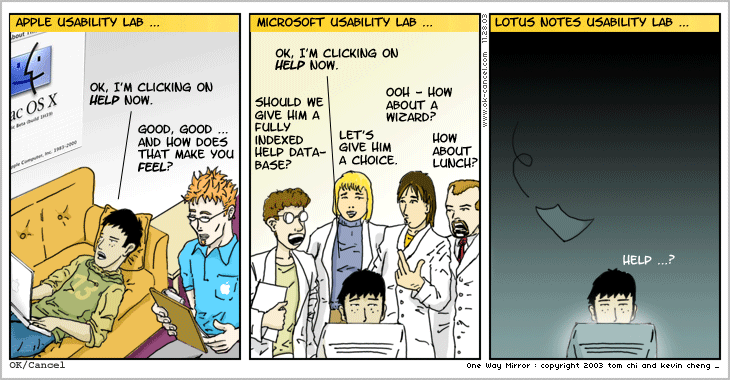Illustration by Juhan Sonin
Usability testing can help you dramatically improve your website or app by watching people use it. We all know this to be true and yet so many of us don’t do a lot of testing. Let’s change this, now!
The 5 simple steps to DIY usability testing
The goal of this article is simple – When you’re done reading, you’ll have everything you need to know to make your first usability test. The idea is not to become an expert, but to encourage you to just start testing whatever you are building by following these 5 simple steps:
- Planning
- Conducting
- Analyzing
- Reporting
- Using the results
1. Planning
To be honest, I advise you not to plan too much. Of course you can spend hours, days or even weeks on planning the perfect usability test. The problem is that the idea of perfection keeps you from testing early and often enough — that’s why we strive for continual improvement instead.
“Testing always works, and even the worst test with the wrong user will show you important things you can do to improve your site.”
— Steve Krug
Your first usability test will suck! You will do almost everything wrong, even if you’re perfectly prepared. The secret of usability testing is to just do it. Not only will you find out what’s wrong with your site but you will also improve your testing skills from session to session.
There’s only one thing that’s important about planning a usability test: Schedule an appointment with a test user and force yourself to stick to this appointment. My personal preference is to schedule a 30-minute Skype call where I ask participants to share their screens with me, or to just ask a friend or colleague nearby to participate in a spontaneous test right then and there.
 Comic found on OK/Cancel. Check out their archives for more comics.
Comic found on OK/Cancel. Check out their archives for more comics.
2. Conducting
If this is your first time to conduct a usability test, here’s how you can do it:
- Give a short intro to your users based on Steve Krug’s example script (PDF).
It’s important to tell people that they can’t do anything wrong and that you’re not testing them but your website/app/prototype. BTW: Steve Krug is the master of DIY usability testing and if you’re keen on learning more about it, I recommend you read his books Don’t Make me Think and Rocket Surgery Made Easy. - Write a scenario that reflects your website’s purpose.
If the purpose of your website is, for example, to sign up and make a donation, you could give the following scenario: “Imagine you decided to donate some money to an organisation you like. Please go ahead and explore this website while you think out loud and try to make a monthly donation of 10$.” - Give your users a specific task to do.
The best way to make sure your users test the features you want to be tested, is to write a specific task scenario. The most obvious example is to test your sign up process by writing something like this: “You’ve explored the site for a few minutes, now please try to sign up for this service and speak your thoughts while doing so.” - Be a silent observer rather than a leading facilitator.
A rule of thumb is that your tester should do at least 80% of the talking. Your job is to observe their behavior and to make sense of what they are saying.
If in doubt, keep your mouth shut or ask open ended questions like “What do you think has happened?” or “What do you expect to happen if you click this link?”.
This may seem a bit overwhelming at first and that’s why I recommend testing with friends and colleagues before doing tests with real customers. This way you’re free to make mistakes (which is important for learning purposes) and you will start to internalize the process of conducting usability tests yourself.
3. Analyzing
Conducting a usability test is one thing, analyzing it is something completely different. And it’s hard to put into words …
That said, it’s unnecessarily complicated to learn how to analyze usability test results if you haven’t done any testing yet. For the sake of this article I suggest you watch the demo usability test from Steve Krug after which you’ll know everything you need to analyze a usability test:
At the end of the demo you are asked to name your top 3 usability findings and you can compare your list with the top 3 findings that Steve himself had discovered. Other than that I just encourage you to do step 1 and 2 in this article.
Also, make sure you record the screen and voice of your users, or try to capture the test sessions by taking notes and paying close attention to what people say — and even more importantly — to how they use your website, app, or prototype.
4. Reporting
Typically usability testing is done by outside experts. The obvious problem with this approach is that these experts need to report the findings to you and your team which usually takes a lot of time and money. By doing the usability tests yourself, it gets a lot easier. Let me explain…
I was once creating a prototype for some web based software and set out to test it with 4 users. At first I wanted to capture their screens and voices during the sessions for later reference. It turned out that it wasn’t necessary since after only one test I had so many results that I decided to cancel the 3 remaining sessions and just walk home to improve my design.
“When a designer runs a test, he or she knows what happened and can immediately start redesigning to fix the problems that the test identified. No meeting, no report, no communications overhead required.”
— Jakob Nielsen
What happened was that since I was testing my own design I was able to analyze and report the results instantly. When the first session was over I had like a dozen of things to improve and ideas to incorporate into my prototype for another round of testing.
5. Using the results
I think you already see where this is going. If you do usability tests yourself, using the results becomes a no-brainer. You see how people have problems with your design, you improve it based on your observations, and repeat this process until your users don’t have any severe problems with your website/app/prototype anymore. It’s the most natural thing I can imagine.
Don’t let the term usability intimidate you — all you have to do is ask someone to try your user interface. You don’t need to be a pro to get real value from watching people using your product and you certainly don’t need to do it right. You just have to do it.
What are you waiting for? First, watch the usability demo test from Steve Krug if you haven’t already. Second, decide what you want to test (for example your marketing site) and go through the above steps.
It’s easier than you might think and you’ll find out even more than you’d expect…even if you’re doing it all wrong 🙂


